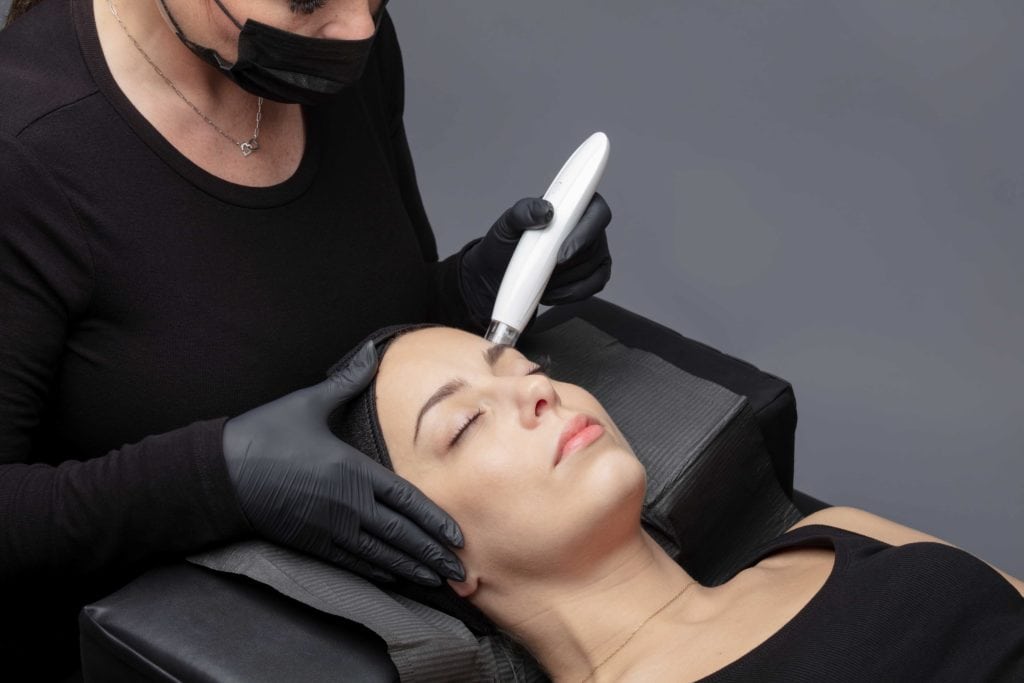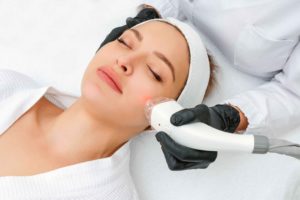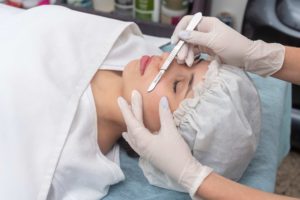
Dermaplaning is a manual exfoliation method that uses minimally invasive procedures and a scalpel or special Dermaplaning tool to scrape off the topmost layer of the skin gently. In other words, it is a medical procedure of manually removing dead skin cells or fine facial hair, known as vellus hair. This results in a soft, smooth surface that most skin products can penetrate quickly and more efficiently.
Aside from enhancing skincare products’ penetration, the main goal of Dermaplaning is to improve the skin’s texture and tone to reduce the appearance of fine lines and wrinkles. Additionally, this also helps increase collagen production and reduce acne scarring.
How Dermaplaning Works
The procedure is a manual exfoliation method done by a licensed esthetician or a dermatologist that, on average, takes around 30 minutes to complete. It is considered a safe procedure for most people and is often related to microdermabrasion and chemical peels.
If you’re sensitive to exfoliation methods or have fine facial hair that you want to remove, Dermaplaning can be considered a gentler approach.
However, people with active acne, rosacea or those taking specific medications must either avoid this procedure or consult their dermatologist or esthetician before proceeding.
What Are the Tools Used in Dermaplaning
As mentioned above, one of the most commonly used tools involved in Dermaplaning is a sterilized scalpel or a specialized Dermaplaning tool. The scalpel is a small sharp blade that will be held at a 45-degree angle to the skin and gently scraped across the skin’s surface to remove your dead skin cells and fine facial hair.
Dermaplaning tools are specifically designed for the procedure and often have a handle and a small, rounded blade similar to a scalpel. These tools are designed to be more gentle on the skin and may have a safety feature to prevent accidental cuts.
In addition to the scalpel and the specialized Dermaplaning tool, some estheticians may also use a soft-bristled brush to remove dead skin cells and then apply a moisturizer or serum for hydration after the procedure.
The steps in Dermaplaning show why you should only get this done by a licensed practitioner.
The Benefits of Dermaplaning
Before you get yourself scheduled with a licensed esthetician, you’ll need to discover whether the benefits of Dermaplaning topple the cons of doing it.
Here are its benefits:
- Improved Skin Texture and Tone
- Diminishes Vellus Hair and Dull Skin Cells
- Reduced Appearance of Fine Lines and Wrinkles
- Improved Penetration of Skincare Products
- Reduces and PreventAcne
- Treats Hyperpigmentation
- Increased Collagen Production
- Reduced Acne Scarring
To sum it all up, Dermaplaning is good for the skin since it is a safe and effective way to improve your skin. From the texture, tone, and improved ability to absorb skincare products, as well as increased collagen production, your skin remains to be youthful-looking once you consider this type of treatment.
What Should You Do Before Undergoing a Dermaplaning Treatment
If you have decided to go through a Dermaplaning treatment, there are a few essential things you need to do. That way, you can get the treatment without regrets and receive the best results.
Always Consult With a Professional
Not all treatments are suitable or compatible with different skin types. Everyone is unique, so you can assume that your skin type might also have the same case. That is why before you go through with the treatment, consult a licensed esthetician or dermatologist. You need to confirm the treatment is appropriate for your skin type.
Stop Using Exfoliating Products
It’s recommended to stop using exfoliating products, such as scrubs or acids, on your skin for a week or two. This ensures that your skin won’t be too sensitive during the treatment and be sensitive to scratches.
Avoid Sun Exposure
You need to avoid too much sun exposure for at least a week before the treatment. Although Vitamin D is healthy, if you get tanned or sunburned skin, this will make your entire experience during the procedure to be uncomfortable. Not only that, but it also increases the potential risk of complications.
Don’t Shave or Wax Your Skin
If you’re planning on Dermaplaning, you must never shave or wax the area targeted for the treatment for at least two days. Shaving and waxing cause your skin to be sensitive, which only aggravates your discomfort.
Cleanse Your Face
Before the procedure, you must clean your face thoroughly. Wash off the makeup, oils, or other impurities that may hinder you from achieving the full benefits of the treatment. This treatment’s goal is to remove all the natural impurities on your face; therefore, all makeup or cosmetics that might get in the way must be cleansed immediately.
1.Be Mentally and Emotionally Prepared
You’re probably anxious or excited to get that youthful-looking skin. However, you must know in advance that you will need a couple or several sessions to benefit from this treatment before you can achieve the results. Besides that, you need to provide the practitioner with your medical history and if you have any skin conditions or are taking any skin medications. In addition, you also need to inform her about allergies as a moisturizer is also used post-treatment.
By following these steps, you can ensure that your Dermaplaning treatment will be effective and comfortable.
FAQS About Dermaplaning
1. How often should you Dermaplane your face?
Most patients get Dermaplaning sessions once a month to get optimal results. The results for your skin improvement can last for at least three weeks.
2.When can you see the results?
Your skin can instantly appear softer on the same day of the treatment. However, the results may vary for each patient. Other patients could only fully see the treatment results in five to seven days.
3.Are there side effects?
Yes, some patients have experienced blemishes, mild irritation, redness, and discoloration on their skin. These symptoms, however, will immediately subside within only a few hours.
4.Is Dermaplaning recommended by doctors?
Although this skin care treatment may look like it’s possible at home to eliminate that peach fuzz, the DIY route is not recommended. Thus, you must only get a Dermaplane from a licensed esthetician who knows the risk and what to do to prevent irritations and complications.
5.What should you do and not do after treatment?
Here are some post-treatment practices that you should follow for a more comfortable experience:
- Avoid direct sun exposure.
- Do not use scrubs or exfoliators on your face for a week or two.
- Don’t go swimming or avoid exposure to chlorine for a week or two.
- Apply serums or moisturizers to keep your skin hydrated.
- Avoid scorching temperatures.
- Always use sunscreen when you go out.





